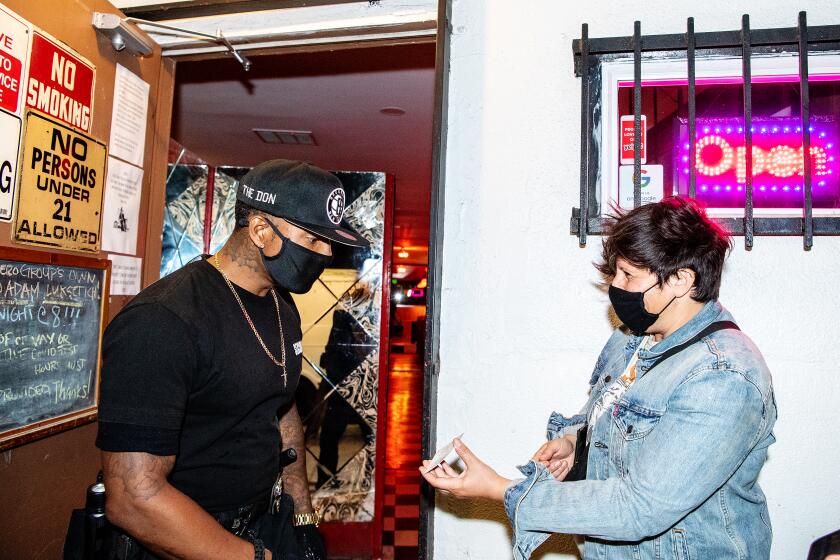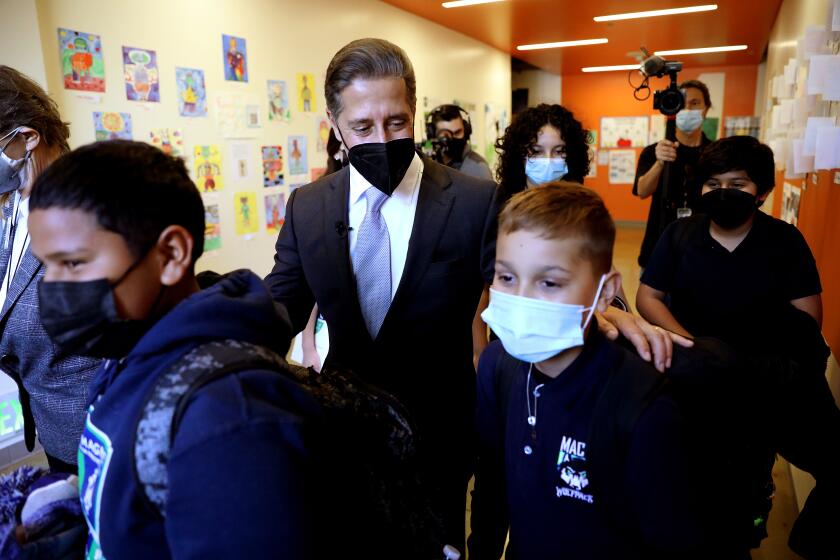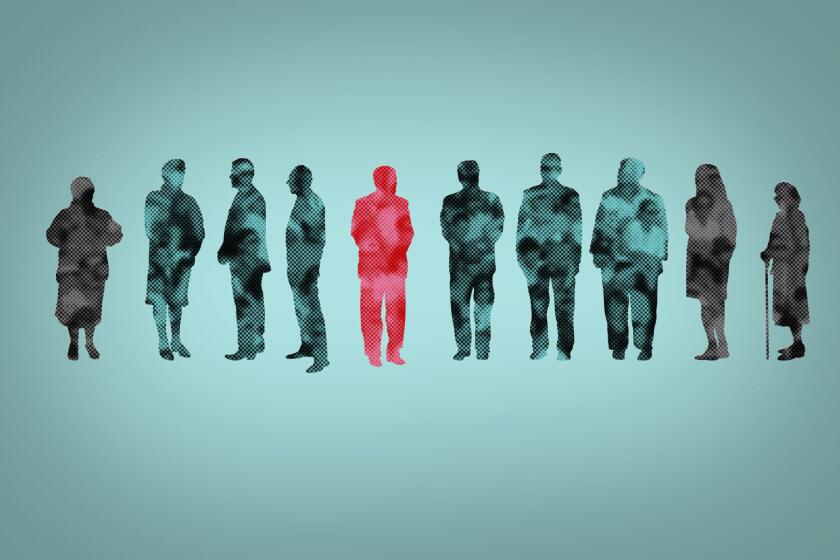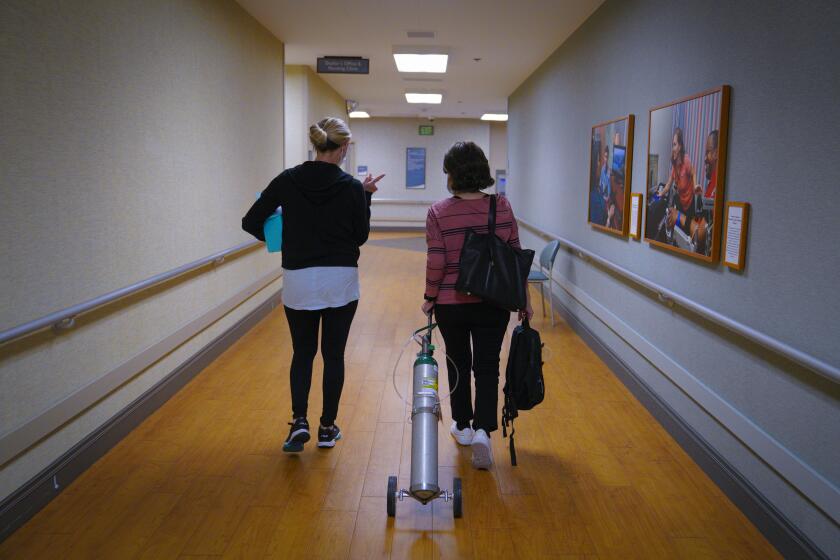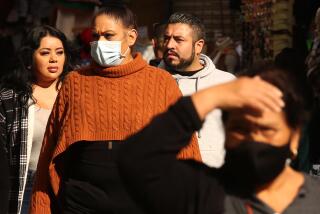L.A. County bars, offices, gyms can drop mask rules with COVID vaccine verification

- Share via
Fully vaccinated individuals will soon be able to shed their masks indoors at Los Angeles County establishments that screen the inoculation status of visitors and patrons, health officials said Wednesday.
While not a complete easing, the revised rules — which take effect at 12:01 a.m. Friday — represent a significant relaxation of the county’s universal indoor mask mandate, which has been in place since July. And depending on how many businesses elect to take advantage, the impact could be both widespread and widely apparent, especially in places like offices, gyms, restaurants, bars and hair salons.
However, it also may be short-lived. County health officials have expressed optimism that the region is mere weeks away from clearing the threshold they’ve set to fully repeal the requirement that fully vaccinated individuals must still mask up in many indoor public places. Doing so would align the county’s rules with those that are in place across the vast majority of California.
But this week’s move nevertheless demonstrates how far the region has come since the heights of the Omicron surge.
“As transmission drops and there is less virus circulating, some tools may afford significant protections against the very worst risks associated with COVID,” L.A. County Public Health Director Barbara Ferrer said in a statement. “Because vaccines are one of these tools, with lower rates of hospital admissions and COVID hospitalizations, it is appropriate in settings verifying vaccination or negative test status that we transition to strongly recommending masking instead of requiring masking.”
Vaccinated Los Angeles County residents may soon be able to go maskless in indoor settings that check for proof that they’ve received their doses, officials said.
According to the new county rules, businesses that are interested in relaxing face covering requirements will have two choices: Make masks optional for customers only, or for both customers and employees.
For the latter, workers and patrons alike would need to show proof of full vaccination or a recent negative coronavirus test to enter, and could unmask inside only if they’re fully vaccinated. Those who aren’t fully vaccinated would still be allowed in with a negative test result, but would need to keep their masks on.
Should a business elect to go the customer-only route, patrons would be subject to the same vaccine-or-test verification requirement, but workers would not.
The rules could ultimately prove too complicated or resource-intensive for businesses such as supermarkets and malls to implement. But they may be easier at shops already required to check for proof of vaccination.
Existing L.A. County regulations require proof of COVID-19 vaccination at indoor bars, wineries, breweries, distilleries, nightclubs and lounges. Far broader rules are in place within the city of L.A., covering additional indoor retail businesses and venues, including restaurants, movie theaters, hair and nail salons, coffee shops, gyms, museums, bowling alleys and performance venues.
The newly established indoor masking exception is also open to virtually any other venue or business, so long as it complies with the county’s verification requirements. For instance, offices could begin to allow fully vaccinated people to go unmasked, as long as they supply proof of full vaccination status.
Full vaccination is defined as having received two doses of the Pfizer-BioNTech or Moderna shots at least 14 days prior to entry; or a single dose of the Johnson & Johnson shot at least 14 days prior to entry.
Unvaccinated individuals would still need to wear masks indoors — a rule that’s in place statewide. And places without vaccine verification will remain subject to the county’s standing indoor mask mandate, which applies to all residents two and older regardless of vaccination status.
Businesses also can choose to retain a universal indoor masking rule, a strategy a number have continued to pursue around California.
The timetable to lift the indoor mask mandate potentially could be even shorter if the federal guidance on face coverings changes.
Masks also would continue to be mandatory for anyone where required by the state or federal government — such as in nursing homes, indoors at K-12 schools or while aboard public transit.
California state officials on Monday are expected to announce a date by which the indoor mask order in K-12 school settings can be eased, although counties and schools will have the option to keep their own orders in place if they choose.
L.A. County’s latest strategy is similar to one pursued in parts of the Bay Area, including San Francisco, between the summertime Delta surge and the Omicron wave that began in the fall and spiked in the winter. There, some county authorities allowed masks to be optional in places like offices and gyms where everyone showed proof of vaccination.
Even with the forthcoming change, however, L.A. County will remain one of only a few jurisdictions in which universal indoor masking is widely required. Other areas in California with universal indoor masking rules include the city of Palm Springs and the counties of Santa Clara and Mendocino.
While L.A. County is decidedly on the downswing of a massive surge fueled by the hyper-infectious Omicron variant of the coronavirus, Ferrer has said transmission remains too high to completely rescind the indoor masking requirement.
The latest maps and charts on the spread of COVID-19 in Los Angeles County, including cases, deaths, closures and restrictions.
The county will instead do so when it reaches “moderate transmission” as defined by the U.S. Centers for Disease Control and Prevention and remains there for seven days. That would mean recording fewer than 730 new coronavirus cases a day over a weekly period.
Currently, the case rate remains more than three times that. However, given how rapidly transmission is waning, Ferrer said she thinks the region could be positioned to relax the rule by mid- to late March.
The approach has not been without controversy, as some residents and elected officials have called on the county to more immediately follow the state’s lead.
“I still think that the better and less confusing approach would be to fully align with the state of California,” county Supervisor Janice Hahn said in a statement Wednesday. “But this is a welcome step in the right direction as our cases decline and we learn to live with this virus.”
According to a Times analysis of county data, L.A. County averaged about 2,600 cases a day over the last week — down nearly 40% from the previous week. The week before that, L.A. County was averaging 8,200 cases a day.
With cases dropping in half roughly every week, L.A. County health officials have estimated the county will reach its goal of fewer than 730 new cases a day by mid-March.
While the trajectory is promising, officials are still voicing caution. L.A. County is still reporting a high level of coronavirus transmission, and the nation’s most populous county remains susceptible to surges, given its higher rates of poverty and crowded housing and large numbers of essential, front-line workers.
Experts say it’s unlikely the highly transmissible Omicron variant — or any other variant — will lead us closer to herd immunity against COVID-19.
And despite recent changes to mask guidance, health officials across California have continued to urge the public to don face coverings in indoor public settings.
“While there are powerful tools that impede virus transmission, none are perfect, which is why we often need to use a variety of safety measures to reduce transmission,” Ferrer said Wednesday. “When transmission is very high, we need to create the most complete shield we can so that’s why it’s important that we layer in all the protections at hand.”
During a live video discussion Tuesday night, a trio of Orange County health officials kept their masks on during the hourlong chat.
Dr. Matthew Zahn, a deputy health officer for Orange County, said the region’s current coronavirus case rate is still comparable to the peak of the Delta surge.
“Is there still a considerable amount of disease in the community, and is it still really important and useful for people to be masking? Absolutely — without a doubt,” Zahn said. “There are many people who are being infected every single day in our community with Omicron.”
Dr. Clayton Chau, director of the Orange County Health Care Agency and the county’s health officer, said he wears a mask both in indoor public places and crowded outdoor settings as further protection against a breakthrough infection. He said he wants to avoid getting infected to protect his 86-year-old mother, who is fully vaccinated and boosted but has a weakened immune system.
A study by scientists at UC Berkeley and the California Department of Public Health recently illustrated the effectiveness of masks in preventing coronavirus infection.
The CDC-published study found that always wearing a mask in indoor settings resulted in someone being less likely to test positive for the coronavirus compared with those who didn’t routinely wear masks.
Those who wore N95 or KN95 masks in public indoor settings had an 83% lower chance of testing positive, and those who wore surgical masks had a 66% lower chance.
Vaccination should temper the number and severity of persistent symptoms.
While much has been made of Omicron’s generally milder nature compared with previous coronavirus strains, officials say getting infected presents a risk not just of serious illness, but of contracting long COVID or worsening chronic conditions.
“We hear a lot about people who have long-haul syndrome or they have rapid heartbeat that just continues for months on end or they’re just too tired,” said Dr. Regina Chinsio-Kwong, an Orange County deputy health officer.
Wearing a mask, she added, helps to “protect myself and my family.”
More to Read
Sign up for Essential California
The most important California stories and recommendations in your inbox every morning.
You may occasionally receive promotional content from the Los Angeles Times.
